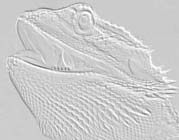 |
 |
|||
 |
||||
|
Parasites are like weeds ... while a weed is just a plant you don't want where it is, a parasite is just an organism that, for the most part, you don't want too many of them where they are. Our bodies, and those of our beardie's, are teeming with microscopic organisms. The digestive tract hosts an enormous range of organisms. Fortunately, most of them happily live out their lives without affecting us. It's those that do affect our beardies that we are most concerned about. A healthy beardie has a number of these organisms, all kept in check by a healthy immune system and beneficial gut flora (the good bacteria). When a beardie is highly stressed, or under prolonged moderate to severe stress, the immune system falters. In cases of improper environmental temperatures, starvation, or prolonged dehydration, the beneficial gut flora die off. This allows the more opportunistic of the organisms (the bad guys) to reproduce and start to become problems. Since the vast majority of reptile parasites and protozoans are too small to see without a microscope, you cannot tell if your beardie has a problem (other than changes that may occur in the color, consistency, and odor of the feces). The only way to know is to properly collect a specimen of fresh feces and have it examined by a reptile vet. Reptile vets are the most familiar with the varieties of reptile-related organisms, and have a better feel for what is considered the normal level of parasites vs. requiring immediate treatment. Or you can do like I have ... get a microscope, some supplies, and start doing your own fecal testing. Click here for more info on doing your own fecal tests. Signs
of Parasite and Protozoan Problems:
Since stress can cause problems in the normal gut flora, it makes sense to have your beardie checked out after they have had a couple of weeks or a month to recover from a major stress event (all newly acquired hatchling and juvenile beardies should be fecal tested within the first month of acquisition). Events such as moving from one home to another, even if the move doesn't involve a change in the humans they belong to, it's always a good idea, as moving is highly stressful to them. Significant changes in the household can also cause enough stress to result in gut flora imbalance. Collecting
Samples for Testing: Coccidia: During treatment with sulfa type drugs (Albon), you should make sure to keep your beardie hydrated. Also during treatment, you should minimize the cage furnishings to an absolute bare minimum. Remove any wooden or porus objects and throw them away. The best way is to keep 2 enclosures and clean one while the other is in use. This will allow for the enclosure to properly air dry, which will keep potentially damaging or deadly odors to a minimum. Soak all cage furnishings with an ammonia solution for 30 minutes. Rinse well. Steam cleaners work great as they don't use any chemicals and the steam (over 165 degrees F) kills coccidia oocysts. You'd be surprised to hear that most disinfectants will not kill coccidia oocysts. The best methods for killing coccidia oocysts are: bleach water solution, steam cleaning (temp above 165 degrees F), and a 10% ammonia solution. Also, boiling or baking cage furniture will kill oocysts. They can not withstand high temps or drying. Please note that I have removed Nolvasan from the above paragraph as an effective disinfectant. I have been informed that Nolvasan will not kill coccidia oocysts. This info came directly from the manufacturer. See my Disinfectants page for more info. Coccidia
Lifecycle: Oocysts develop and escape from the cells and are passed in the feces. This starts the cycle all over again. Typically, when an oocyst is passed in the feces it is not infectious yet because it does not contain the infection causing sporozoites. In 2 or 3 days, after being deposited with the feces, the oocysts develop sporozoites and become infectious. The lifecycle of coccidia is only 14 days. But infectious oocysts can live and survive in your beardies environment for months, even years! Proper cage hygiene is very important! Note: Flies can carry oocysts from one place to another and spread the parasite to other areas of your house, even to other beardies. Watch out for those pesky flies!
Primary source of information: Melissa Kaplan's website (www.anapsid.org) and "Understand Reptile Parasites" by Roger Klingenberg D.V.M. |
||||
| This information should be used only as a reference tool and should not be used in place of vet assistance. My views and opinions are the result of hours of dedicated research. But remember, I am not a professional. If you have a sick beardie and don't know what to do, don't play God, take him to the vet immediately. | ||||
|
Copyright
© Beautiful Dragons. All Rights Reserved.
This website may not be copied or reproduced without my permission. |
||||